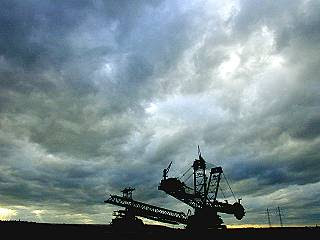The Bagger 288 (Excavator 288), built by the German company Krupp for the energy and mining firm Rheinbraun, is a bucket-wheel excavator.
More specifically, it is a mobile strip mining machine. When its construction was completed in 1978, Bagger 288 superseded NASA's Crawler-Transporter, used to carry the Space Shuttle and Apollo missions, as the largest tracked vehicle in the world at 13,500 tons. However, the Bagger is powered from an external source and is more correctly described as a mining machine which can be moved, while the crawler-transporter was built as a self-powered, load-carrying vehicle.
The Bagger 288 was built for the job of removing overburden prior to coal mining in Tagebau Hambach (stripmine Hambach), Germany. It can excavate 240,000 tons of coal or 240,000 cubic metres of overburden daily – the equivalent of a football field dug to 30 m (98 ft) deep. The coal produced in one day fills 2400 coal wagons. The excavator is up to 220 m (721 ft) long and approximately 96 m (315 ft) high. The Bagger's operation requires 16.56 megawatts of externally supplied electricity.[1] It can travel 2 to 10 m (6.6 to 33 ft) per minute (0.1 to 0.6 km/h). The chassis of the main section is 46 m (150 ft) wide and sits on 3 rows of 4 caterpillar track assemblies, each 3.8 m (12 ft) wide. The large surface area of the tracks means the ground pressure of the Bagger 288 is very small (17.1 N/cm2 or 24.8 psi); this allows the excavator to travel over gravel, earth and even grass without leaving a significant track. It has a minimum turning radius of approximately 100 meters, and can climb a maximum gradient of 1:18.
The excavating head itself is 21.6 m in diameter and has 18 buckets each holding 6.6 cubic meters (7.9 yd³) of overburden.
By February 2001, the excavator had completely exposed the coal source at the Tagebau Hambach mine and was no longer needed there. In three weeks it made a 22 kilometer (14 mile) trip to the Garzweiler mine, traveling across Autobahn 61, the river Erft, a railroad line, and several roads. The move cost nearly 15 million German marks and required a team of seventy workers. Rivers were crossed by placing large steel pipes for the water to flow through and providing a smooth surface over the pipes with rocks and gravel. Special grass was seeded to smooth its passage over valuable terrain. Moving Bagger 288 in one piece was more economical than disassembling the excavator and moving it piece by piece.
(From Wikipedia)
More specifically, it is a mobile strip mining machine. When its construction was completed in 1978, Bagger 288 superseded NASA's Crawler-Transporter, used to carry the Space Shuttle and Apollo missions, as the largest tracked vehicle in the world at 13,500 tons. However, the Bagger is powered from an external source and is more correctly described as a mining machine which can be moved, while the crawler-transporter was built as a self-powered, load-carrying vehicle.
The Bagger 288 was built for the job of removing overburden prior to coal mining in Tagebau Hambach (stripmine Hambach), Germany. It can excavate 240,000 tons of coal or 240,000 cubic metres of overburden daily – the equivalent of a football field dug to 30 m (98 ft) deep. The coal produced in one day fills 2400 coal wagons. The excavator is up to 220 m (721 ft) long and approximately 96 m (315 ft) high. The Bagger's operation requires 16.56 megawatts of externally supplied electricity.[1] It can travel 2 to 10 m (6.6 to 33 ft) per minute (0.1 to 0.6 km/h). The chassis of the main section is 46 m (150 ft) wide and sits on 3 rows of 4 caterpillar track assemblies, each 3.8 m (12 ft) wide. The large surface area of the tracks means the ground pressure of the Bagger 288 is very small (17.1 N/cm2 or 24.8 psi); this allows the excavator to travel over gravel, earth and even grass without leaving a significant track. It has a minimum turning radius of approximately 100 meters, and can climb a maximum gradient of 1:18.
The excavating head itself is 21.6 m in diameter and has 18 buckets each holding 6.6 cubic meters (7.9 yd³) of overburden.
By February 2001, the excavator had completely exposed the coal source at the Tagebau Hambach mine and was no longer needed there. In three weeks it made a 22 kilometer (14 mile) trip to the Garzweiler mine, traveling across Autobahn 61, the river Erft, a railroad line, and several roads. The move cost nearly 15 million German marks and required a team of seventy workers. Rivers were crossed by placing large steel pipes for the water to flow through and providing a smooth surface over the pipes with rocks and gravel. Special grass was seeded to smooth its passage over valuable terrain. Moving Bagger 288 in one piece was more economical than disassembling the excavator and moving it piece by piece.
(From Wikipedia)
(Click to see large picture)





Comments
JCB for sale